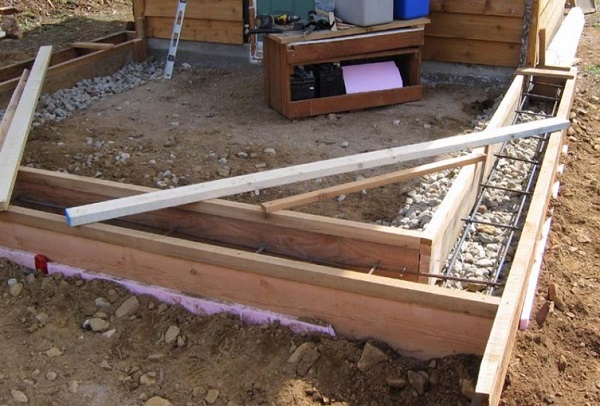Building foundations

|
| Sambro Island storage building. |
Contents |
[edit] What are building foundations for?
Foundations provide support for structures, transferring their load to layers of soil or rock that have sufficient bearing capacity and suitable settlement characteristics to support them.
[edit] What affects the design of foundations?
There are a very wide range of foundation types suitable for different applications, depending on considerations such as:
- The nature of the load requiring support.
- Ground conditions.
- The presence of water.
- Space availability.
- Accessibility.
- Sensitivity to noise and vibration.
[edit] What are the different categories of foundations?
Very broadly, foundations can be categorised as shallow foundations or deep foundations.
- Shallow foundations are typically used where the loads imposed by a structure are low relative to the bearing capacity of the surface soils.
- Deep foundations are necessary where the bearing capacity of the surface soils is not adequate to support the loads imposed by a structure and so those loads need to be transferred to deeper layers with higher bearing capacity.
[edit] What are the types of shallow foundations?

|

|

|
| Trench fill foundation. | Rubble trench foundation. | Raft foundation. |
[edit] Strip foundations (or footings)
Strip foundations provide a continuous strip of support to a linear structure such as a wall. For more information, see Strip foundation.
Trench fill foundations are a variation of strip foundations, in which the trench excavation is almost completely filled with concrete. For more information see: Trench fill foundation.
Rubble trench foundations are a further variation of trench fill foundations, and are a traditional construction method which uses loose stone or rubble to minimise the use of concrete and improve drainage.
For more information see: Rubble trench foundations.
[edit] Pad foundations
Pad foundations are rectangular or circular pads used to support localised loads such as columns.
For more information see: Pad foundations.
[edit] Raft foundations
Raft foundations are slabs that cover a wide area, often the entire footprint of a building, and are suitable where ground conditions are poor, settlement is likely, or where it may be impractical to create individual strip or pad foundations for a large number of individual loads. Raft foundations may incorporate beams or thickened areas to provide additional support for specific loads.
For more information see: Raft foundations.
[edit] What are the types of deep foundations?

|

|

|
| Pile driver | Sheet piles | Diaphragm wall |
[edit] What are piles?
Pile foundations are long, slender, columns typically made from steel or reinforced concrete, or sometimes timber.
Generally piles are classified as; end-bearing piles (where most of the friction is developed at the toe of the pile, bearing on a hard layer), or friction piles (where most of the pile-bearing capacity is developed by shear stresses along the sides of the pile, suitable when harder layers are too deep). Piles are most commonly; driven piles prefabricated off site and then driven into the ground, or bored piles that are poured in situ. If the boring and pouring takes place simultaneously, the piles are called continuous flight augured (CFA) piles.
For more information see: Pile foundations.
A range of commonly used pile foundations are described below.
[edit] Mini piles (or micro piles/micropiles)
Mini piles are used where access is restricted, for example underpinning structures affected by settlement. They can be driven or screw piles.
For more information see: Micropiles.
[edit] Pile walls
By placing piles directly adjacent to one another, a permanent or temporary retaining wall can be created. These can be closely-spaced contiguous pile walls, or interlocking secant walls, which depending on the composition of the secondary intermediate piles can be hard/soft, hard/firm or hard/hard secant walls.
For more information see: Pile walls
[edit] Diaphragm walls
Diaphragm walls are made by excavating a deep trench that is prevented from collapsing by being filled with engineering slurry such as bentonite and then the trench is filled with reinforced concrete panels, the joints between which can be water-tight. This is commonly used for top-down construction, where a basement is constructed at the same time as above ground works are carried out.
For more information, see Diaphragm wall.
[edit] Caissons
Caissons are watertight retaining structures sunk into the ground by removing material from the bottom, typically this might be suitable for building structures below water level.
For more information, see Caisson.
[edit] Compensated foundations
If a very large amount of material is excavated (for example, where there is a deep basement), it may be sufficient that the relief of stress due to the excavation is equal to the applied stress from the new construction. As a result, there should be little effective change in stress and little settlement.
For more information, see Compensated foundation.
[edit] Ground anchors
Ground anchors transfer very high loads by using a grouted anchor to mechanically transfer load from a tendon to the ground. They can be pre-tensioned, or can be tensioned by the applied load.
For more information, see Ground anchor.
[edit] Related articles on Designing Buildings
- Bearing capacity.
- Compensated foundation.
- Continuous flight auger piles.
- Driven piles.
- Footings.
- Geothermal pile foundations.
- Ground anchor.
- How deep should foundations be?
- How to design a pad foundation.
- Micropiles.
- Pad foundation.
- Pile foundations.
- Principles of foundations.
- Raft foundation.
- Rubble trench foundation.
- Screw pile foundations.
- Stepped foundation.
- Strip foundation.
- Trench.
- Trench fill foundation.
- Underwater foundations.
Featured articles and news
Homes England supports Greencore Homes
42 new build affordable sustainable homes in Oxfordshire.
Zero carbon social housing: unlocking brownfield potential
Seven ZEDpod strategies for brownfield housing success.
CIOB report; a blueprint for SDGs and the built environment
Pairing the Sustainable Development Goals with projects.
Types, tests, standards and fires relating to external cladding
Brief descriptions with an extensive list of fires for review.
Latest Build UK Building Safety Regime explainer published
Key elements in one short, now updated document.
UKGBC launch the UK Climate Resilience Roadmap
First guidance of its kind on direct climate impacts for the built environment and how it can adapt.
CLC Health, Safety and Wellbeing Strategy 2025
Launched by the Minister for Industry to look at fatalities on site, improving mental health and other issues.
One of the most impressive Victorian architects. Book review.
Common Assessment Standard now with building safety
New CAS update now includes mandatory building safety questions.
RTPI leader to become new CIOB Chief Executive Officer
Dr Victoria Hills MRTPI, FICE to take over after Caroline Gumble’s departure.
Social and affordable housing, a long term plan for delivery
The “Delivering a Decade of Renewal for Social and Affordable Housing” strategy sets out future path.
A change to adoptive architecture
Effects of global weather warming on architectural detailing, material choice and human interaction.
The proposed publicly owned and backed subsidiary of Homes England, to facilitate new homes.
How big is the problem and what can we do to mitigate the effects?
Overheating guidance and tools for building designers
A number of cool guides to help with the heat.
The UK's Modern Industrial Strategy: A 10 year plan
Previous consultation criticism, current key elements and general support with some persisting reservations.
Building Safety Regulator reforms
New roles, new staff and a new fast track service pave the way for a single construction regulator.























Comments
[edit] To make a comment about this article, click 'Add a comment' above. Separate your comments from any existing comments by inserting a horizontal line.
Great photo - you wouldnt want to be in it when there was a gust of wind.